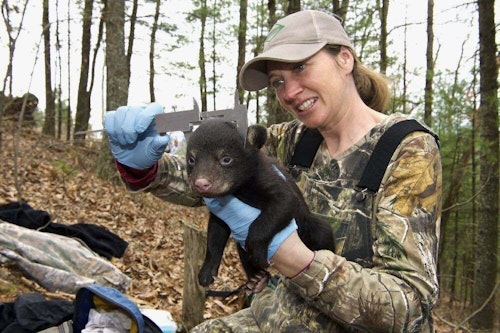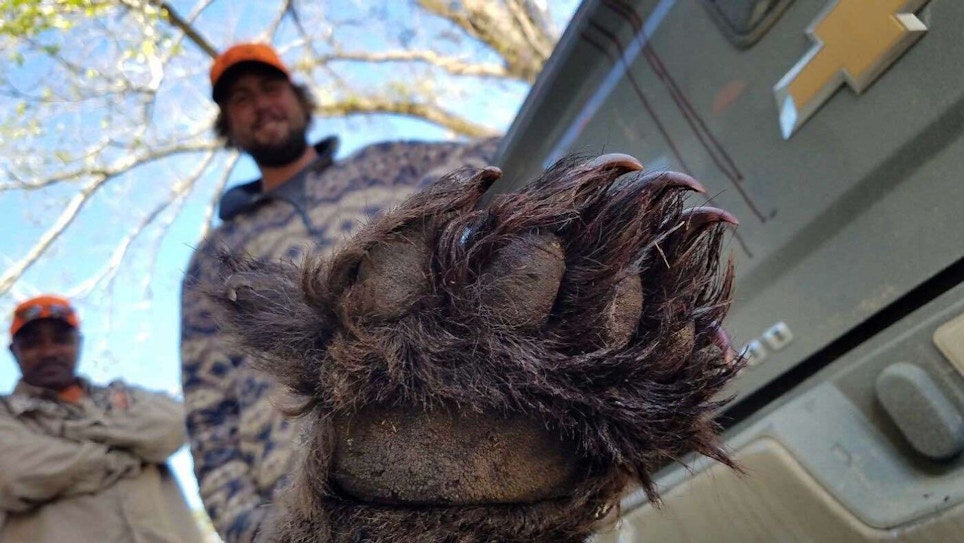In the first beautiful days of winter, something splendid transpires in nature. Black bears are well into their long hibernation, having stocked up the fat stores to get through the cold months. While in hibernation they do not eat or excrete waste, their heart rate and body temperature lowers, yet they lose no muscle mass or bone density. While the females idle through the weeks in cramped winter dens, they give birth.
Along about January and February, cubs come into the world and begin to nurse while the mother continues to hibernate. The females will stir occasionally to clean the cubs but spend most the winter in a lethargy. When the northern hemisphere wobbles back into the vernal position and the weather warms, the female shakes off the siesta and she and her 8-pound cubs emerge when all things are new. It is truly remarkable.
And so is this — a great deal of what we know about black bear biology has been the result of consistent and reliable funding available to state fish and wildlife agencies with the passage of the Pittman-Robertson Act in 1937. The manufacturer excise taxes on firearms, archery gear, and ammunition propelled wildlife research and management on feathered and furred animals, bears included. The black bear work underway by the North Carolina Wildlife Resources Commission (NCWRC) affords us an excellent example of how Pittman-Robertson funds conserve wildlife.

North Carolina Case Study
Continuously since 1969, the manufacturer excise taxes have funded North Carolina black bear conservation work — the work of researchers asking first, the elemental questions of how many bears existed on the landscape, and second, how and where they lived.
Such work continues under the stewardship of Colleen Olfenbuttel, NCWRC’s Bear & Furbearer Biologist (photo above).
“Pittman-Robertson has paid for black bear research and management in North Carolina in at least 20 long-term research projects through seven different colleges located in six states, and in many cases training future wildlife professionals,” said Olfenbuttel. “Wildlife managers long before me faced a dilemma of very few black bears in North Carolina. In 1970, only a few hundred bears lived in isolated pockets. That is when we started a concerted effort to answer questions to conserve bears over the long horizon.”
They succeeded. Today, Olfenbuttel faces what she calls a “new dilemma,” a robust bear population with a growing human population where 20,000 bears live over 70 percent of the state, mostly in the western and eastern portions of North Carolina.
Science guides bear management and regulated hunting is the principal management tool. Some 52,900 people hunt bears in North Carolina, mostly with rifles, running dogs, and harvest around 4,000 bears each year.
“Bear hunting is important in North Carolina,” said Olfenbuttel. “It lends itself to family activities, cultural heritage, and offers social cohesion — and bears feed people. Hunters use the whole bear for protein and soups, and lard for cooking and waterproofing. The lard is clear and odorless. There’s a great amount of food sharing among families and non-hunters that comes about from bear hunts.”
Olfenbuttel calculates that in one bear season, hunters take away 152 tons of meat yielding over 600,000 meals.
The world record black bear came from the eastern part of North Carolina: 880 pounds. Hunters come to North Carolina from nearly all 50 states and other continents to take advantage of what Pittman-Robertson and science-based wildlife management has produced, which includes the biological and ecological health of a natural system.
With a whole lot of interest in bear hunting in North Carolina, Olfenbuttel says it’s important to be dexterous in managing bear numbers, and that requires solid data. Data collection is labor- and equipment-intensive.

“We couldn’t do it without Pittman-Robertson,” said Olfenbuttel. “It pays for the gas in our trucks, GPS collars, dart rifles, pharmaceuticals, tattoo pens, ear tags, game cameras, sardines for bait stations, stethoscopes, blood work, dental tools to pull teeth from harvested bears to determine age, and boots on the ground in the forest counting acorn mast that bears eat. The funding is so vital — nothing else comes close to offering the support.”
That manner of support is ongoing in 16 other states where since 1987, Pittman-Robertson has funded nearly 90 projects designed to restore, conserve, and manage black bear populations. To learn more, visit www.partnerwithapayer.org






